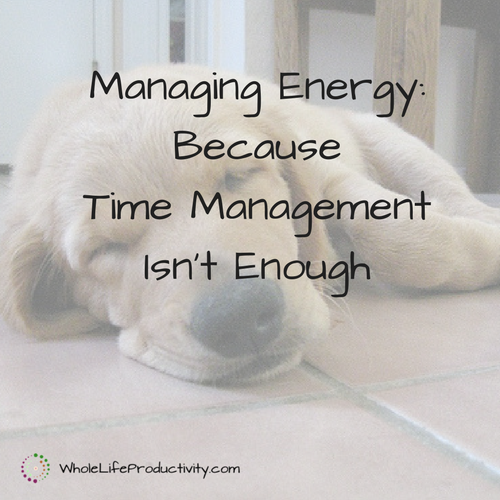
Consolidate To Combat Information Overwhelm
This article originally appeared on SimpleProductivityBlog.com. It has been revised and updated.
One of my readers asked me to address the question of what to do when you have information in too many places. She said she had notebooks everywhere, plus all her email accounts, plus sticky notes scribbled on and stuck all over her house and office. She said she lost things constantly, missed appointments, and misplaced valuable notes and information.
I can empathize. As I write this I have two planners on my desk (work and personal), two notebooks, a pile of paper, and three email accounts open. There are a series of sticky notes stuck to the edge of my monitor, and I have my personal calendar open in my planner and on my screen, trying to reconcile the information. (How do I have two dentist appointments next week?)
Everyone has a lot of information. It’s probably not a matter of getting rid of it, but rather getting it together.
You Probably Don’t Have Too Much Information…
The first sign of having information in too many places is that we start to feel overwhelmed by information. You look at your notebooks and can’t figure out where to write something, or where to find something you put in there last week. You remember getting an email, but you can’t remember which account, or where you filed it. You see the pile of sticky notes in front of you, and think of all the things in your lists in various places, and you don’t know where to start.
It’s not just a matter of distraction. It can lead to procrastination, or not knowing where to start, or working on other things just to escape the press of the tasks.
…It’s Probably Just In Too Many Places
The problem really isn’t that there is too much: it’s that it’s all over the place, so everywhere you turn you are reminded of things you need to do.
Think of each little piece of information as being a child clamoring for your attention. You know you need to attend to them all, but as they keep shouting at you, you are going to be pulled in all sorts of directions and get nothing done.
Instead of letting them all shout at you, take a page from classroom management: give them a place to be, and deal with them systematically, one at a time. And unlike classroom management, you don’t have to give them an activity while they wait. And as a teacher would approach a classroom, you’re going to group the students together and deal with them in groups.
The solution to all of this information overwhelm is consolidation.
How To Consolidate
Consolidating your information can be done easily if you approach it in a methodical way. The goal of this is to minimize the places you put information by looking at what types of information you capture, where you put it in, and where you use it.
1. Pull Everything Together
The first thing is to pull everything together. In the interest of not overwhelming yourself, I would recommend picking one specific type of input, such as calendar, notes, tasks, or phone numbers.
Make a list of every place you have this type of information. For instance, if you were to look at you calendar information, you might have information in your computer, your phone, three notebooks, and a stack of appointment cards on your desk.
Pull this information together into one place so you can the put it where it needs to be.
1b. Separate Into Types
If you chose to not heed my advice about choosing a singe type of information, you now need to classify what type of information has been gathered.
Pull all the information into the same type. All calendar information in one pile, all phone numbers in another, all notes in a third, etc.
It may be that multiple types of information is in one place; for instance, you might have phone numbers in a notebook along with project notes. If this is the case, put a sticky on each item saying what types of information is in them, and place them in a separate pile.
Having these piles will make it easier to get all the information where it needs to be.
2. Decide Where It Will Go
You have the source; now you need the destination. Decide where your ultimate repository for the information will be. For example, all of your contacts and phone numbers could be in your phone. Or in a planner. Or some other combination. It doesn’t matter as long as the solution works for you. But it does matter that you know where it goes.
Deciding on the final location means that you will have one place to check, and one place to enter.
A note about duplication:
It may very well be that you need to have information in more than one place. For instance, I have an electronic calendar that is my source, but as a family we need to have the paper calendar in the kitchen. So once a month I transfer the information from my electronic calendar to the paper one. This may happen, and it is OK. If you have a scenario like this, choose your final destination as the one that is most flexible to access.
3. Transfer Your Information
Next comes cleanup. Take all those bits of information that are not in their permanent location and put them where they need to be.
This is the part where it is easy to make excuses to do it later. I’ll not kid you: the job can be tedious, but think of how much time you will save in not having to search around the house/desk/wallet later on.
4. Keeping It Up
Once the initial round of cleanup is done, you will need to keep it up. (Sorry, this is not one of those do-once activities).
Make an appointment with yourself that once a week you will pull everything together and get it where it needs to go. Spend a half hour every week and make sure you put the information where you can get to it.
Consolidating your information makes it easier to find things, and gets you away from being overwhelmed. Gather it, classify it, and get it where it needs to be, and you’ll be able to find things much easier.
Like this article? Share it using the buttons below, or forward it to a friend.
Image by Rubber Dragon. Licensed under Creative Commons. Text added.



